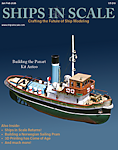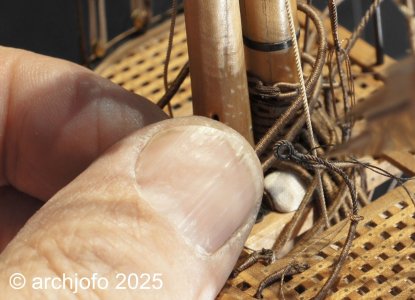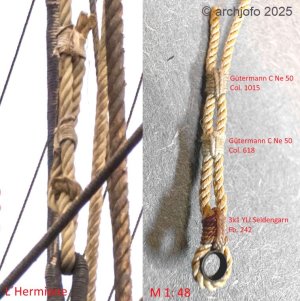-

Win a Free Custom Engraved Brass Coin!!!
As a way to introduce our brass coins to the community, we will raffle off a free coin during the month of August. Follow link ABOVE for instructions for entering.
-

PRE-ORDER SHIPS IN SCALE TODAY!
The beloved Ships in Scale Magazine is back and charting a new course for 2026!
Discover new skills, new techniques, and new inspirations in every issue.
NOTE THAT OUR FIRST ISSUE WILL BE JAN/FEB 2026
You are using an out of date browser. It may not display this or other websites correctly.
You should upgrade or use an alternative browser.
You should upgrade or use an alternative browser.
La Créole 1827 by archjofo - Scale 1/48 - French corvette
- Joined
- Sep 3, 2021
- Messages
- 5,155
- Points
- 738

Impressive work. Using various rope- and block sizes gives the model an aura of authenticity.@Mirek
@GrantTyler
Thank you for your interest and the nice comments.
Also, thank you all for the likes.
Attaching the Yards with Running Rigging: Foreyard - Vergue de misaine
The final rigging of the model of La Créole began with the attachment of the fore yard and running rigging.
The first step is to suspend the yard using the slings. These consisted of strong ropes with a diameter of 43 mm (0.90 mm in 1:48), fully served.
While jeer blocks were probably a permanent part of the rigging in the past, towards the end of the 18th century the French began removing the jeer blocks after hoisting the lower yards, as they realized they were not absolutely necessary for holding the yards. Thus, the slings carry the weight of the yard. This was certainly a relief and an advantage when sailing sharply.
View attachment 513907
View attachment 513908
For the model, I first provisionally positioned the foreyard using the lifts, so that I could then place the slings around the mast and connect them using seizing.
The required seizing must be applied directly to the model. Getting this done cleanly and correctly will certainly not be easy.
But more on that soon...
- Joined
- Feb 8, 2025
- Messages
- 262
- Points
- 138

Thank you so much for posting such a detailed log, your work is just awesome, you have answered all my questions about French ships from the1800, Now if I can just make mine look like yours I would be a very happy sailor, Fantastic work 
Bobby K
Bobby K
After your message, I tried to do it last night by following your advice on tying yarn and it turned out great...I am grateful for your advice again. I did not use glue and the result was as I wanted... I continue to learn something new every day... It's going great for me.[KULLANICI=9293]@Peter Voogt[/KULLANICI]
[KULLANICI=27229]@KAYA61[/KULLANICI]
[KULLANICI=15636]@Herman[/KULLANICI]
Merhaba,
İlginiz ve çalışmalarım hakkındaki olumlu yorumunuz için teşekkür ederim.
Ayrıca beğenileriniz için hepinize teşekkür ederim.
[KULLANICI=27229]@KAYA61[/KULLANICI]
İhtiyacınız olan bilgileri size sağlamaktan mutluluk duyarım. Aşağıdaki görsellerin yeterli olduğunu umuyorum. Değilse lütfen tekrar iletişime geçin.
View attachment 513911
View attachment 513912
View attachment 513913
- Joined
- Nov 10, 2019
- Messages
- 469
- Points
- 373

@Steef66
@Mirek
@RDN1954
@Bobby K.
@KAYA61
Thank you very much for your encouragement. It's very motivating, especially when it comes to the very tricky work in the rigging. You always have to be extremely careful not to get caught on something.
Also, many thanks to everyone for the likes.
Continuation: Attaching the fore yard - Vergue de misaine - with the running rigging
Attaching the seizings to the slings was child's play compared to tying thimbles to the ends of the truss pendants.

The prepared truss tackles will then be hooked into these thimbles. Therefore, the thimbles could only be tied in afterward. Before doing so, a section of the serving at the rope ends had to be removed.

As already mentioned, I then hooked the prepared truss tackles into these thimbles and the corresponding eyebolts on the cap and led the running ropes down over redirection blocks to the fife rail behind the foremast for belaying.


More on this soon...
@Mirek
@RDN1954
@Bobby K.
@KAYA61
Thank you very much for your encouragement. It's very motivating, especially when it comes to the very tricky work in the rigging. You always have to be extremely careful not to get caught on something.
Also, many thanks to everyone for the likes.
Continuation: Attaching the fore yard - Vergue de misaine - with the running rigging
Attaching the seizings to the slings was child's play compared to tying thimbles to the ends of the truss pendants.

The prepared truss tackles will then be hooked into these thimbles. Therefore, the thimbles could only be tied in afterward. Before doing so, a section of the serving at the rope ends had to be removed.

As already mentioned, I then hooked the prepared truss tackles into these thimbles and the corresponding eyebolts on the cap and led the running ropes down over redirection blocks to the fife rail behind the foremast for belaying.


just gorgeous!!! As always, you can spend hours looking at the details.@Steef66
@Mirek
@RDN1954
@Bobby K.
@KAYA61
Thank you very much for your encouragement. It's very motivating, especially when it comes to the very tricky work in the rigging. You always have to be extremely careful not to get caught on something.
Also, many thanks to everyone for the likes.
Continuation: Attaching the fore yard - Vergue de misaine - with the running rigging
Attaching the seizings to the slings was child's play compared to tying thimbles to the ends of the truss pendants.
View attachment 514201
The prepared truss tackles will then be hooked into these thimbles. Therefore, the thimbles could only be tied in afterward. Before doing so, a section of the serving at the rope ends had to be removed.
View attachment 514198
As already mentioned, I then hooked the prepared truss tackles into these thimbles and the corresponding eyebolts on the cap and led the running ropes down over redirection blocks to the fife rail behind the foremast for belaying.
View attachment 514199
View attachment 514200
- Joined
- Dec 28, 2024
- Messages
- 139
- Points
- 113

Amazing work! So intricate and clean. In fact, one could imagine this isn't even a model, it's a real ship fresh out of the shipyard with lots of macro photos to make it look like a model. Of course I don't believe that, but it is that realistic.
- Joined
- Nov 10, 2019
- Messages
- 469
- Points
- 373

@serikoff
@Bobby K.
@bowwild
Thank you for your kind comments.
Thanks also to everyone else for the likes.
Continuation: Attaching the fore yard - Vergue de misaine - with running rigging
Following up to my previous post, here are two more pictures and a brief explanation of how to make a seizing for the sling directly on the model.
The first picture shows me holding and securing the two sling ropes together with tweezers on the left. Using the tweezers on the right, I then wrapped the yarn (spun yarn) around the two ropes. I then pulled the yarn through twice between the ropes, perpendicular to the winding. Finally, the end was tucked under one of the two yarns and pulled tight in the middle. I only soaked the free end of the yarn with a tiny amount of superglue. Thin superglue penetrates the yarn well, so that even after trimming off the excess yarn, it is still sufficiently secured.
The goal is to make the superglue completely unnoticeable, which doesn't always work perfectly. It's very important not to get the superglue on the seizing itself. Otherwise, the superglue will negatively affect the appearance of the seizing.

The result can be seen in the second picture:

I hope I made that clear.
To be continued ...
@Bobby K.
@bowwild
Thank you for your kind comments.
Thanks also to everyone else for the likes.
Continuation: Attaching the fore yard - Vergue de misaine - with running rigging
Following up to my previous post, here are two more pictures and a brief explanation of how to make a seizing for the sling directly on the model.
The first picture shows me holding and securing the two sling ropes together with tweezers on the left. Using the tweezers on the right, I then wrapped the yarn (spun yarn) around the two ropes. I then pulled the yarn through twice between the ropes, perpendicular to the winding. Finally, the end was tucked under one of the two yarns and pulled tight in the middle. I only soaked the free end of the yarn with a tiny amount of superglue. Thin superglue penetrates the yarn well, so that even after trimming off the excess yarn, it is still sufficiently secured.
The goal is to make the superglue completely unnoticeable, which doesn't always work perfectly. It's very important not to get the superglue on the seizing itself. Otherwise, the superglue will negatively affect the appearance of the seizing.

The result can be seen in the second picture:

I hope I made that clear.
To be continued ...
- Joined
- Aug 8, 2019
- Messages
- 5,522
- Points
- 738

How do you do that? I use a small sewing needle where I cut the eye in half to get a needle that looks like a 2-toothed fork. The glue stick between the tooth and can be transfer to the rope in a tiny amount. Do you have a better way?It's very important not to get the superglue on the seizing itself.
- Joined
- Aug 8, 2019
- Messages
- 5,522
- Points
- 738

Clear.Hello Stephan,
I use a very thin superglue from Toolcraft, nothing special, which I can easily dose with a 0.3 mm cannula attached. When the needle dries out, I simply burn it clean with a lighter.
- Joined
- Jul 27, 2021
- Messages
- 418
- Points
- 323

I love these highres images Johann! Love it!
Dirk
Dirk
üstadım bu bagın adı SEİZİNG diye geciyor ,ınternete yazarsan detaylarını bulurusun,yelkenlı gemılerde en cok kullanılan saglam bır bagÇok naziksiniz, teşekkür ederim... Yanılmıyorsam iplikleri düğümlemiyorsunuz... Düğümlemeyince iplikler nasıl bir arada duruyor?
- Joined
- Dec 3, 2022
- Messages
- 1,547
- Points
- 488

Hello Johann, I have read to the foot of page 4 only, but since I will require several days to catch up I wanted to give my immediate impressions of your work.
I've never seen anything quite like this. I am a novice ship modeller and have been admiring the work of many of the more experienced and skilled members of this forum. Your work on La Creole is something else again. I had no idea that it was possible to work to this high standard.
I do not aspire to such excellence in my own work, I am neither that dedicated nor determined, but now that I know that it's possible to work in the penthouse suite as you do, maybe with some effort I can lift myself out of the basement car park. If were to advance just one or two levels towards La Creole, I would be a very happy modeller.
Thank you for the writing the log so clearly and for the superb photographs which are together teaching me so much.
I've never seen anything quite like this. I am a novice ship modeller and have been admiring the work of many of the more experienced and skilled members of this forum. Your work on La Creole is something else again. I had no idea that it was possible to work to this high standard.
I do not aspire to such excellence in my own work, I am neither that dedicated nor determined, but now that I know that it's possible to work in the penthouse suite as you do, maybe with some effort I can lift myself out of the basement car park. If were to advance just one or two levels towards La Creole, I would be a very happy modeller.
Thank you for the writing the log so clearly and for the superb photographs which are together teaching me so much.
- Joined
- Oct 15, 2017
- Messages
- 1,190
- Points
- 443

Johann, I'm now caught up on your wonderful build. Just when I thought you had done all you could to impress with your skills, tying off that thimble with the rope in place, among all the other rigging, is just amazing, just from a dexterity perspective, especially with those giant thumbs!@Steef66
@Mirek
@RDN1954
@Bobby K.
@KAYA61
Thank you very much for your encouragement. It's very motivating, especially when it comes to the very tricky work in the rigging. You always have to be extremely careful not to get caught on something.
Also, many thanks to everyone for the likes.
Continuation: Attaching the fore yard - Vergue de misaine - with the running rigging
Attaching the seizings to the slings was child's play compared to tying thimbles to the ends of the truss pendants.
View attachment 514201
The prepared truss tackles will then be hooked into these thimbles. Therefore, the thimbles could only be tied in afterward. Before doing so, a section of the serving at the rope ends had to be removed.
View attachment 514198
As already mentioned, I then hooked the prepared truss tackles into these thimbles and the corresponding eyebolts on the cap and led the running ropes down over redirection blocks to the fife rail behind the foremast for belaying.
View attachment 514199
View attachment 514200
 With your macro photography skills, it's important to have a good manicure.
With your macro photography skills, it's important to have a good manicure.What speaks to the level of your skill is that magnification shows the flaws of most modelers' work; your work looks better under magnification!
Wonderful work!
Last edited:
- Joined
- Aug 30, 2020
- Messages
- 676
- Points
- 353

The details looks so good, amazing work.@Steef66
@Mirek
@RDN1954
@Bobby K.
@KAYA61
Thank you very much for your encouragement. It's very motivating, especially when it comes to the very tricky work in the rigging. You always have to be extremely careful not to get caught on something.
Also, many thanks to everyone for the likes.
Continuation: Attaching the fore yard - Vergue de misaine - with the running rigging
Attaching the seizings to the slings was child's play compared to tying thimbles to the ends of the truss pendants.
View attachment 514201
The prepared truss tackles will then be hooked into these thimbles. Therefore, the thimbles could only be tied in afterward. Before doing so, a section of the serving at the rope ends had to be removed.
View attachment 514198
As already mentioned, I then hooked the prepared truss tackles into these thimbles and the corresponding eyebolts on the cap and led the running ropes down over redirection blocks to the fife rail behind the foremast for belaying.
View attachment 514199
View attachment 514200
- Joined
- Nov 10, 2019
- Messages
- 469
- Points
- 373

@Steef66
@Dubz Modelling World
@Smithy
@Oktay Yaylacıkoral tay
@Hoss6262
@Richie
Hello,
First of all, I would like to thank you for your interest in my model building.
Many thanks also to everyone else for the LIKES.
Let's continue with a small detail:
Continued: Running Rigging - Seizings
Before I continued rigging my French corvette, here the lifts of the fore yard, I asked myself the fundamental question of how and with what I should perform the required seizing of the running rigging.
In my search for an example of original rigging, I found what I was looking for in the replica of the L'Hermione. This appears to be the fore topsail halyard, a similar situation to the one used to attach the tackles for the lifts. As discussed several times in another forum, the running rigging was also lightly tarred, as was the spun yarn for the seizing.
In the following picture, I have compared three possible seizings for my model with the example from the L'Hermione.
Accordingly, I'll opt for the top option, as I believe it's closest to the original.

As already mentioned with the standing rigging, the need for thimbles for a sailing ship model is enormous. This, of course, also applies to the running rigging. Therefore, I'll have to make some more thimbles.
To be continued...
@Dubz Modelling World
@Smithy
@Oktay Yaylacıkoral tay
@Hoss6262
@Richie
Hello,
First of all, I would like to thank you for your interest in my model building.
Many thanks also to everyone else for the LIKES.
Let's continue with a small detail:
Continued: Running Rigging - Seizings
Before I continued rigging my French corvette, here the lifts of the fore yard, I asked myself the fundamental question of how and with what I should perform the required seizing of the running rigging.
In my search for an example of original rigging, I found what I was looking for in the replica of the L'Hermione. This appears to be the fore topsail halyard, a similar situation to the one used to attach the tackles for the lifts. As discussed several times in another forum, the running rigging was also lightly tarred, as was the spun yarn for the seizing.
In the following picture, I have compared three possible seizings for my model with the example from the L'Hermione.
Accordingly, I'll opt for the top option, as I believe it's closest to the original.

As already mentioned with the standing rigging, the need for thimbles for a sailing ship model is enormous. This, of course, also applies to the running rigging. Therefore, I'll have to make some more thimbles.
To be continued...
